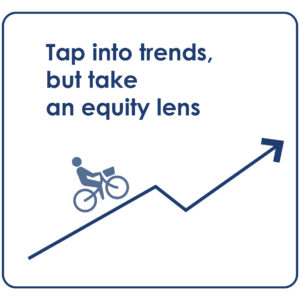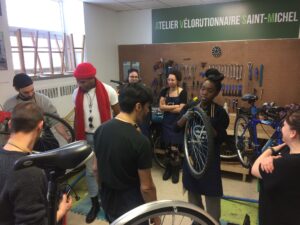 Large-scale trends related to cycling in Canada have greatly contributed to its increase. In the case studies we conducted, no other category was cited as crucial in every one of the ten municipalities studied.
Large-scale trends related to cycling in Canada have greatly contributed to its increase. In the case studies we conducted, no other category was cited as crucial in every one of the ten municipalities studied.
These trends include a change in cycling culture and how people perceive cycling. Cycling has become fashionable and media coverage of cycling is more positive. As a result, cycling is now more commonly viewed as a legitimate form of transportation. The social status of car ownership and use has declined among some groups, especially younger generations who are comfortable using shared mobility to meet their transportation needs. Particularly in urban settings, Canadians are becoming more aware of the benefits of cycling for health and the negative impacts of car travel. Macro cultural, social and economic trends related to cycling in Canada have greatly contributed to its increase. In the case studies we conducted, no other category was cited as crucial in every one of the ten municipalities studied. These trends include a change in cycling culture and how people perceive cycling. Cycling has become fashionable and media coverage of cycling is more positive. As a result, cycling is now more commonly viewed as a legitimate form of transportation. The social status of car ownership and use has declined among some groups, especially younger generations who are comfortable using shared mobility to meet their transportation needs. Particularly in urban settings, Canadians are becoming more aware of the benefits of cycling for health and the negative impacts of car travel.
At the same time, cycling in Canada has increased more (Manaugh & Winters, publication pending) in wealthier neighbourhoods and neighbourhoods located closer to a downtown core. The association of cycling with gentrification and the attraction of hip, young professionals to central areas presents an equity challenge for practitioners. In particular, as downtowns gentrify and become more expensive and more exclusive, suburban areas are seeing their populations shift to include a greater number of low income and new immigrant residents, many of whom do not own cars. Cycling can offer an additional transportation option, but cycling investments in these areas are often lower than in the downtown. These patterns can be addressed by bringing an equity lens to cycling infrastructure and programming investments. There is much a municipality can do to make trends more inclusive and ensure that all groups have access to cycling.
ACTIONS
- Establish a community identity as a place where people cycle. Create a program name, logo and brand elements to unify efforts to promote cycling and build a compelling and positive media and marketing presence.
- Promote diverse images of cycling through social marketing, including people of different races, genders and ages using different types of bicycles in both urban and suburban environments.
- Collaborate with public health authorities, community health centres, parks and recreation and environmental groups on programs that encourage cycling as part of a healthy, sustainable lifestyle.
- Recognize that cycling is increasing in popularity with populations outside of the young, urban professional category, and tailor programming to reach these groups, including women, older adults, newcomers and those living outside of downtown.
- Analyse your existing and planned cycling network through an equity lens to identify potential disparities in access based on income, race, neighbourhood, immigration status, etc.
- Provide programs to increase access to bicycles in lower income neighbourhoods.
EXAMPLES

- In Toronto, a recent survey found over 80% support for a safe cycling across the city, including in the inner suburban communities of Etobicoke, North York and Scarborough.
- Copenhagen’s “I Bike CPH” brand is recognized around the world, and a City of Vancouver report points to how this has helped define that city as a leader in active transportation and liveability.
- Hamilton’s “Everyone Rides” initiative increases access to its bike share system through subsidized memberships, learn-to-ride lessons, free monthly group rides, training on the bike share system and translation for newcomers.
- Cyclo Nord Sud, an advocacy group in Montréal, operates “Vélorution,” a community bike hub that offers cycling lessons, bike rides, repair assistance, and workshops in Saint-Michel, a neighbourhood with a high number of immigrant and low income residents. The initiative started out as a mobile hub and opened the doors of its first permanent location in 2018. A second borough, Côte-des-Neiges Notre-Dame-de-Grâce, has hired them to start a similar project in their community.
- In Toronto, CultureLink Settlement and Community Services, offers “Bike Host” to newcomers to Canada. The program loans them a bicycle and pairs them with a local cycling mentor. The program has been offered for over eight years and has expanded into surrounding suburban communities.
- Calgary actively tracks the age and gender of people cycling through manual counts conducted annually with the goal of providing safe opportunities for Calgarians to bike more regardless of age, gender, income or ability. In 2018, 25% of people cycling were female, up from 21% in 2013, and 3% were children, up from 2% in 2013.
- The City of Portland commissioned Portland State University to conduct an equity gap analysis of its Portland Bicycle Plan for 2030, based on indicators of income, race, and age (children/youth and older adults). The report identified areas of high disadvantage and currently low access to cycling facilities, and recommended prioritizing certain projects to better serve these areas.






